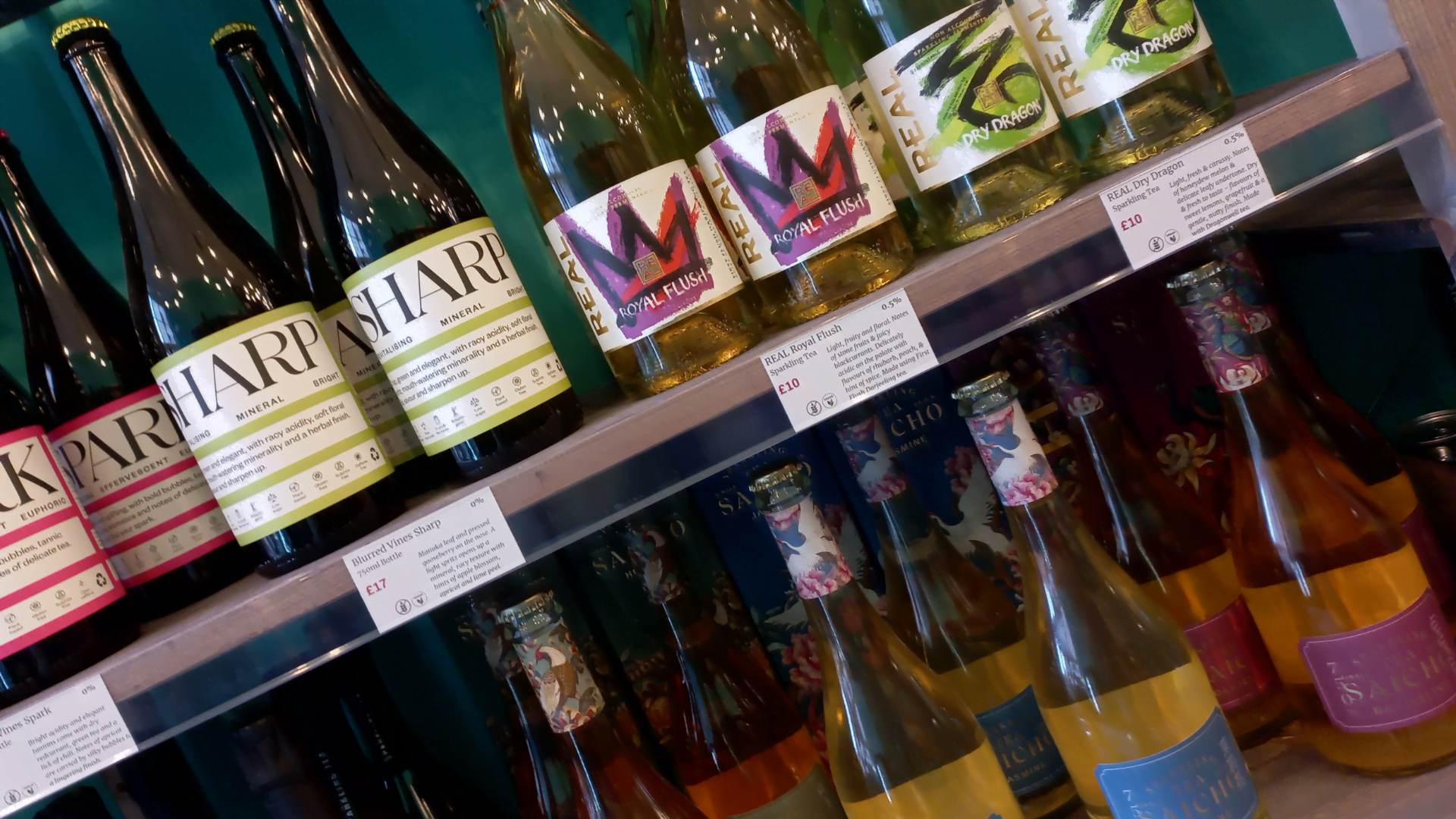
This website uses cookies to improve your experience. We'll assume you're ok with this, but you can opt-out if you wish. Read More
The Next Round: What happens after you change your drinking?

One of the most exciting aspects of the alcohol-free drinks space is the constant reinvention of how we understand drinking.
No drink sums this up more than sparkling tea. Often served in champagne bottles, sparkling tea has made inroads into the space that alcohol-free wines have occupied. By creating its own flavours, sparkling tea defies comparison to an alcoholic equivalent, which can be where alcohol-free wines fall down.
For many sparkling tea producers, the impetus to make their teas comes from seeing the inequality in experience for people who are not drinking alcohol in wine spaces.
“The reason we first got into non-alcoholic drinks was that my wife Natalie can’t drink anything,” shared the founder of Saicho, Charlie Winkworth-Smith. “We found that particularly when we went out for meals and I had wonderful wine pairing options that she was missing out.”
“When we started thinking about what could be an alternative for her, we were thinking what other ingredients had that sort of heritage that wine has. Where it really matters is the terroir, the climate, the production methods, and tea was completely top of that list.”
It was a similar story for Jacob Kocemba, co-founder of Copenhagen Sparkling Tea. “[Jacob] realised the many possibilities within the world of tea when he couldn’t find a matching wine for dessert, despite a wine cellar of more than 1700 wines,” Bo Sten Hansen, co-founder of Copenhagen Sparkling Tea tells us.
“Instead the solution came in a homemade tea extract, which consisted of a blend of different exclusive teas. The new drink quickly became a great success and a favourite among the guests of the restaurant.”
Saicho makes its sparkling tea through a cold-brew method. “You get a very different flavour [from teas] when you cold brew vs. hot brew,” says Charlie Winkworth-Smith.
“It’s a bit more delicate and you get more of the top notes. Then we add a bit of grape juice and sweetness, a bit of acid, and sparkle it. The key is just using really good tea.”
David Begg, and REAL, go beyond sparkling teas for their drinks by fermenting them. “The lengths we go to in our fermentation process are more akin to the creation of a champagne.”
“We start with a very simple flavour profile but once you ferment, you are generating both the complex flavour compounds that yeasts create, in the same way that wine does, and you are also creating the acids that provide the punchy acidity and body that you get out of our products. You have a note of tea, and those teas are the origin story. But it’s not until you ferment that you actually create the full complexity of the product.”
Sparkling teas have already found their way onto menus at numerous Michelin-starred restaurants but there’s no reason why you need to be having a fancy meal to enjoy one.
Copenhagen Sparkling Tea recommends approaching their drinks with an open mind. “The human brain has a tendency to search for ways to compare and compartmentalise things. We fully understand that people try to do the same with sparkling tea,” says Bo Sten Hansen.
“However, we always try to remind people that this is a completely new beverage category. The taste is completely unique and unlike anything else. The Lyserod is a great choice for light salty dishes such as seafood and charcuterie.”
REAL suggests thinking of them as a fruity prosecco or sparkling wine. “You’re getting a product that has the same sort of mouthfeel and complexity as a sparkling wine,” says David Begg.
“We’re relatively dry but our fermentation process produces some notes that are very fruity. We’ll get some notes of rhubarb, gooseberry and white peach in our Royal Flush. We’ll get notes of lemon and grapefruit in our Dry Dragon. This is not a product to be downed,” he adds. “It is a slow sippable high-quality fermentation just like a sparkling wine.”
At Saicho, each of their sparkling teas suits a different occasion. “Our Jasmine is really light, refreshing and floral,” explains Winkworth-Smith. “So it’s great to have before a meal or with canapes.”
“The Darjeeling is quite fruity. It’s got a lot more astringency so it pairs really well with grilled meats. Then our Hojicha has really unique flavours. It’s savoury and umami. So that’s great with savoury food.”
Clearly, sparkling teas are at their best when paired with food but all of the producers saw them as fitting perfectly into any occasion where you would normally plump for a sparkling wine.
It is a category that looks set to continue to grow with Saicho in particular dreaming big. “My absolute ambition is that one day we could be selling the most incredible quality tea for £100, £200 a bottle, and people wouldn’t be thinking that’s outrageous for a non-alcoholic drink,” says Winkworth-Smith.
“In the same way that most people can’t afford a £200 bottle of wine but there’s an understanding that it’s really special and it’s probably worth that if you could really splash out.” Don’t worry though, right now you can still get your hands on sparkling teas for more reasonable prices. “I think it’s a while before we can be charging hundreds of pounds for a bottle,” he laughs.
To try the sparkling teas mentioned in this article, visit the Club Soda Tasting Room at 39 Drury Lane, London, where our team will happily pop open a bottle for you to taste and fall in love with – cheers!
This website uses cookies to improve your experience. We'll assume you're ok with this, but you can opt-out if you wish. Read More
| Name | Domain | Purpose | Expiry | Type |
|---|---|---|---|---|
| wpl_user_preference | joinclubsoda.com | WP GDPR Cookie Consent Preferences. | 1 year | HTTP |
| PHPSESSID | www.tickettailor.com | PHP generic session cookie. | 55 years | HTTP |
| AWSALB | www.tickettailor.com | Amazon Web Services Load Balancer cookie. | 7 days | HTTP |
| YSC | youtube.com | YouTube session cookie. | 55 years | HTTP |
| Name | Domain | Purpose | Expiry | Type |
|---|---|---|---|---|
| VISITOR_INFO1_LIVE | youtube.com | YouTube cookie. | 6 months | HTTP |
| Name | Domain | Purpose | Expiry | Type |
|---|---|---|---|---|
| _ga | joinclubsoda.com | Google Universal Analytics long-time unique user tracking identifier. | 2 years | HTTP |
| sbjs_migrations | joinclubsoda.com | Sourcebuster tracking cookie | 55 years | HTTP |
| sbjs_current_add | joinclubsoda.com | Sourcebuster tracking cookie | 55 years | HTTP |
| sbjs_first_add | joinclubsoda.com | Sourcebuster tracking cookie | 55 years | HTTP |
| sbjs_current | joinclubsoda.com | Sourcebuster tracking cookie | 55 years | HTTP |
| sbjs_first | joinclubsoda.com | Sourcebuster tracking cookie | 55 years | HTTP |
| sbjs_udata | joinclubsoda.com | Sourcebuster tracking cookie | 55 years | HTTP |
| sbjs_session | joinclubsoda.com | SourceBuster Tracking session | Session | HTTP |
| Name | Domain | Purpose | Expiry | Type |
|---|---|---|---|---|
| mailchimp_landing_site | joinclubsoda.com | Mailchimp functional cookie | 28 days | HTTP |
| __cf_bm | tickettailor.com | Generic CloudFlare functional cookie. | Session | HTTP |
| NID | google.com | Google unique id for preferences. | 6 months | HTTP |
| Name | Domain | Purpose | Expiry | Type |
|---|---|---|---|---|
| _ga_10XZMT03ZM | joinclubsoda.com | --- | 2 years | --- |
| AWSALBCORS | www.tickettailor.com | --- | 7 days | --- |
| cf_clearance | tickettailor.com | --- | 1 year | --- |
| VISITOR_PRIVACY_METADATA | youtube.com | --- | 6 months | --- |
Join Club Soda for 10% off your first order of drinks for UK delivery. Plus get our latest news and special offers for members to choose better drinks, change your drinking and connect with others.
If you get an error message with this form, you can also sign up at eepurl.com/dl5hPn